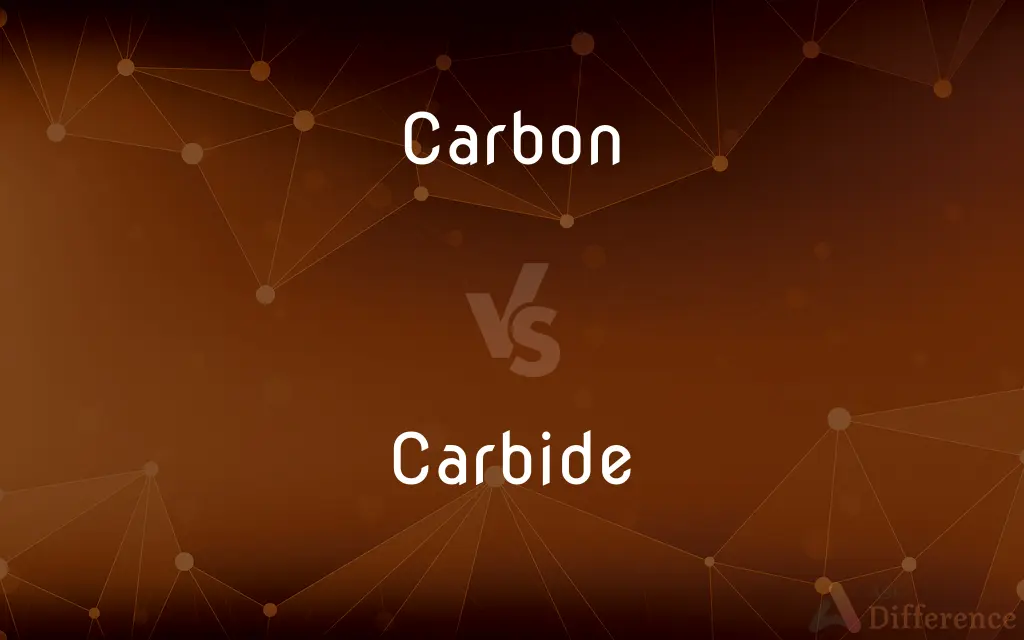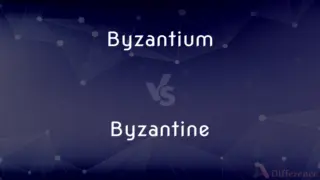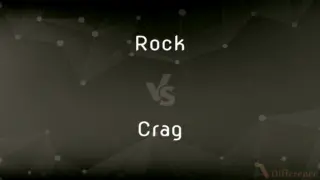Carbon vs. Carbide — What's the Difference?
By Tayyaba Rehman & Urooj Arif — Updated on April 5, 2024
Carbon is a fundamental chemical element essential for life, while carbide refers to compounds composed of carbon and a less electronegative element.

Difference Between Carbon and Carbide
Table of Contents
ADVERTISEMENT
Key Differences
Carbon is a nonmetal that can exist in different allotropes, including graphite, diamond, and amorphous forms, each with unique physical properties. On the other hand, carbide consists of carbon and a more electropositive element, often metals, resulting in compounds with varying properties depending on the metal involved.
While carbon is essential for organic chemistry, forming the backbone of organic molecules, carbide compounds are crucial in industrial applications for their hardness and high melting points. Carbides are often used in cutting tools, abrasives, and as steel additives.
Carbon's versatility in bonding allows for a vast array of organic compounds, ranging from fuels to DNA. Carbides, however, are characterized by their strong covalent or ionic bonds between carbon and the other element, leading to materials that are typically very hard and resistant to wear.
In environmental contexts, carbon plays a pivotal role in the carbon cycle, a fundamental component of Earth's climate system. Carbides, while not directly involved in natural cycles, are significant in industrial processes that can impact environmental health through emissions and waste.
Carbon's ability to form compounds with a wide variety of elements makes it a cornerstone of chemistry and life as we know it. In contrast, carbides' utility lies more in their physical properties and applications in materials science and engineering.
ADVERTISEMENT
Comparison Chart
Composition
Pure element
Compound of carbon and another element
Types/Allotropes
Graphite, diamond, amorphous, etc.
Silicon carbide, calcium carbide, etc.
Primary Use
Organic chemistry, fuel
Industrial tools, abrasives
Bonding
Covalent with various elements
Strong covalent or ionic with metals/nonmetals
Physical Properties
Varies with allotrope
Generally hard and high melting point
Compare with Definitions
Carbon
A naturally occurring element with symbol C and atomic number 6.
Diamond and graphite are allotropes of carbon.
Carbide
Compounds consisting of carbon and a more electropositive element.
Silicon carbide is known for its hardness and thermal conductivity.
Carbon
The basis of organic chemistry and life's molecular structures.
Carbon bonds can form long chains and rings.
Carbide
Used in manufacturing cutting tools and abrasives.
Tungsten carbide tools cut through steel with ease.
Carbon
A key component in fuels, plastics, and many other materials.
Carbon's presence in coal makes it a crucial energy source.
Carbide
Often found in industrial and materials science applications.
Carbide inserts are used in machining for their wear resistance.
Carbon
Found in various forms, from soft graphite to hard diamond.
Carbon fiber is prized for its strength and lightweight.
Carbide
Characterized by their extreme hardness and high melting points.
Carbide compounds are essential in metalworking processes.
Carbon
Integral to the Earth's carbon cycle, affecting climate and life.
Plants convert carbon dioxide into oxygen through photosynthesis.
Carbide
Can form through chemical reactions between carbon and metal.
Calcium carbide reacts with water to produce acetylene gas.
Carbon
Carbon (from Latin: carbo "coal") is a chemical element with the symbol C and atomic number 6. It is nonmetallic and tetravalent—making four electrons available to form covalent chemical bonds.
Carbide
In chemistry, a carbide usually describes a compound composed of carbon and a metal. In metallurgy, carbiding or carburizing is the process for producing carbide coatings on a metal piece.
Carbon
The chemical element of atomic number 6, a non-metal which has two main forms (diamond and graphite) and which also occurs in impure form in charcoal, soot, and coal.
Carbide
A binary compound consisting of carbon and a more electropositive element, especially calcium.
Carbon
Carbon dioxide or other gaseous carbon compounds released into the atmosphere, associated with climate change
Fossil fuel consumption and carbon emissions continued to rise
The level of carbon in the atmosphere has been consistently rising
Carbide
Any of various hard durable materials made of compacted binary compounds of carbon, especially those with silicon, boron, or a heavy metal, used as abrasives and in tools that cut metal.
Carbon
Symbol C An abundant nonmetallic element that occurs in many inorganic and in all organic compounds, exists freely in amorphous, graphite, and diamond forms and as a constituent of coal, limestone, and petroleum, and is capable of chemical self-bonding to form an enormous number of chemically, biologically, and commercially important molecules. Other significant allotropes include fullerenes and nanotubes. Atomic number 6; atomic weight 12.011; sublimation point 3,825°C; triple point 4,489°C; specific gravity of amorphous carbon 1.8 to 2.1, of diamond 3.15 to 3.53, of graphite 1.9 to 2.3; valence 2, 3, 4. See Periodic Table.
Carbide
(chemistry) Any binary compound of carbon and a more electropositive element Category:en:Carbon
Carbon
A carbon-containing gas, notably carbon dioxide, or a collection of such gases, especially when considered as a contributor to the greenhouse effect
Plans for capturing and sequestering carbon produced by power plants.
Carbide
(chemistry) The polyatomic ion C22−, or any of its salts.
Carbon
A sheet of carbon paper.
Carbide
(chemistry) The monatomic ion C4−, or any of its salts.
Carbon
A carbon copy.
Carbide
(chemistry) A carbon-containing alloy or doping of a metal or semiconductor, such as steel.
Carbon
Either of two rods through which current flows to form an arc, as in lighting or welding.
Carbide
(chemistry) Tungsten carbide.
Carbon
A carbonaceous electrode in an electric cell.
Carbide
(cycling) trivial name for calcium carbide (CaC2), used to produce acetylene in bicycle lamps in the early 1900s.
Carbon
(uncountable) The chemical element (symbol C) with an atomic number of 6. It can be found in pure form for example as graphite, a black, shiny and very soft material, or diamond, a colourless, transparent, crystalline solid and the hardest known material. Category:en:Carbon
Carbide
A binary compound of carbon with some other element or radical, in which the carbon plays the part of a negative; - formerly termed carburet.
Carbon
(countable) An atom of this element, in reference to a molecule containing it.
A methane molecule is made up of a single carbon with four hydrogens.
Carbide
A binary compound of carbon with a more electropositive element
Carbon
A sheet of carbon paper.
Carbon
A carbon copy.
Carbon
A fossil fuel that is made of impure carbon such as coal or charcoal.
Carbon
Carbon dioxide, in the context of climate change. Category:en:Climate change
Carbon neutral
Carbon
A carbon rod or pencil used in an arc lamp.
Carbon
A plate or piece of carbon used as one of the elements of a voltaic battery.
Carbon
(informal) carbon fiber.
Carbon bike frame
Carbon
To cause (someone) to receive a carbon copy of an email message.
When I send it, I'll carbon Julia so she's aware.
Carbon
An elementary substance, not metallic in its nature, which is present in all organic compounds. Atomic weight 11.97. Symbol C. it is combustible, and forms the base of lampblack and charcoal, and enters largely into mineral coals. In its pure crystallized state it constitutes the diamond, the hardest of known substances, occuring in monometric crystals like the octahedron, etc. Another modification is graphite, or blacklead, and in this it is soft, and occurs in hexagonal prisms or tables. When united with oxygen it forms carbon dioxide, commonly called carbonic acid, or carbonic oxide, according to the proportions of the oxygen; when united with hydrogen, it forms various compounds called hydrocarbons. Compare Diamond, and Graphite.
Carbon
A carbon rod or pencil used in an arc lamp; also, a plate or piece of carbon used as one of the elements of a voltaic battery.
Carbon
A sheet of carbon paper.
Carbon
A carbon copy.
The formation of the compounds of carbon is not dependent upon the life process.
Carbon
An abundant nonmetallic tetravalent element occurring in three allotropic forms: amorphous carbon and graphite and diamond; occurs in all organic compounds
Carbon
A thin paper coated on one side with a dark waxy substance (often containing carbon); used to transfer characters from the original to an under sheet of paper
Carbon
A copy made with carbon paper
Common Curiosities
What is carbon?
Carbon is a chemical element, symbol C, vital for life and the basis of organic chemistry.
How are carbon and carbide different in composition?
Carbon is a pure element, while carbide is a compound containing carbon and another element.
What is carbide?
Carbide refers to any of a group of compounds composed of carbon and one or more less electronegative elements.
Can carbon exist in different forms?
Yes, carbon exists in several allotropes, including graphite, diamond, and amorphous forms.
What are carbides used for?
Carbides are widely used in industrial applications such as cutting tools, abrasives, and as additives in steel production.
Are carbides naturally occurring?
Some carbides, like silicon carbide, can occur naturally, but many are synthesized for industrial use.
What makes carbides desirable in manufacturing?
Their hardness and high melting points make carbides ideal for cutting tools and abrasives.
How does the carbon cycle work?
The carbon cycle involves the exchange of carbon between Earth's atmosphere, oceans, biosphere, and geosphere, crucial for sustaining life.
How does carbon contribute to life on Earth?
Carbon is the foundational element in organic chemistry, forming the backbone of all known life forms.
How are carbides formed?
Carbides are typically formed through high-temperature reactions between carbon and metals.
Are all carbides equally hard?
While carbides are generally hard, their specific hardness and properties can vary depending on the metal involved.
What's the difference between carbon's and carbide's bonding?
Carbon forms covalent bonds with a variety of elements, while carbides typically have strong covalent or ionic bonds with metals.
Can carbides be used in electronics?
Yes, certain carbides like silicon carbide are used in electronics for their semiconductor properties.
What role does carbon play in climate change?
Carbon dioxide, a greenhouse gas produced by burning carbon-based fuels, contributes significantly to climate change.
Why are carbon and carbides important in industrial processes?
Carbon is essential for producing energy and synthetic materials, whereas carbides are critical for their physical properties in manufacturing.
Share Your Discovery

Previous Comparison
Byzantium vs. Byzantine
Next Comparison
Rock vs. CragAuthor Spotlight
Written by
Tayyaba RehmanTayyaba Rehman is a distinguished writer, currently serving as a primary contributor to askdifference.com. As a researcher in semantics and etymology, Tayyaba's passion for the complexity of languages and their distinctions has found a perfect home on the platform. Tayyaba delves into the intricacies of language, distinguishing between commonly confused words and phrases, thereby providing clarity for readers worldwide.
Co-written by
Urooj ArifUrooj is a skilled content writer at Ask Difference, known for her exceptional ability to simplify complex topics into engaging and informative content. With a passion for research and a flair for clear, concise writing, she consistently delivers articles that resonate with our diverse audience.















































